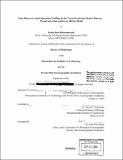| dc.contributor.advisor | David E. Housman. | en_US |
| dc.contributor.author | Boissonneault, Katie Rose, 1973- | en_US |
| dc.contributor.other | Woods Hole Oceanographic Institution. | en_US |
| dc.date.accessioned | 2007-10-22T19:53:30Z | |
| dc.date.available | 2007-10-22T19:53:30Z | |
| dc.date.copyright | 2004 | en_US |
| dc.date.issued | 2004 | en_US |
| dc.identifier.uri | http://hdl.handle.net/1721.1/39415 | |
| dc.description | Thesis (Ph. D.)--Joint Program in Biological Oceanography (Massachusetts Institute of Technology, Dept. of Ocean Engineering; and, the Woods Hole Oceanographic Institution), 2004. | en_US |
| dc.description | Includes bibliographical references (leaves 169-180). | en_US |
| dc.description.abstract | Toxic algae are a growing concern in the marine environment. One unique marine diatom, Pseudo-nitzschia multiseries (Hasle) Hasle, produces the neurotoxin domoic acid, which is the cause of amnesic shellfish poisoning. The molecular characterization of this organism has been limited to date. Therefore, the focus of this thesis was to identify and initiate characterization of actively expressed genes that control cell growth and physiology in P. multiseries, with the specific goal of identifying genes that may play a significant role in toxin production. The first step in gene discovery was to establish a complementary DNA (cDNA) library and a database of expressed sequence tags (ESTs) for P. multiseries. 2552 cDNAs were sequenced, generating a set of 1955 unique contigs, of which 21% demonstrated significant similarity with known protein coding sequences. Among the genes identified by sequence similarity were several involved in photosynthetic pathways, including fucoxanthin-chlorophyll a/c light harvesting protein and a C4-specific pyruvate, orthophosphate dikinase. Several genes that may be involved in domoic acid synthesis were also revealed through sequence similarity, for example, glutamate dehydrogenase and 5-oxo-L-prolinase. In addition, the identification of sequences that appear novel to Pseudo-nitzschia may provide insight into unique aspects of Pseudo-nitzschia biology, such as toxin production. Genes whose expression patterns were correlated with toxin production were identified by hybridization to a microarray manufactured from 5376 cDNAs. 121 cDNAs, representing 12 unique cDNA contigs or non-redundant cDNAs, showed significantly increased expression levels in P. multiseries cell populations that were actively producing toxin. | en_US |
| dc.description.abstract | (cont.) The up-regulated transcripts included cDNAs with sequence similarity to 3-carboxymuconate cyclase, phosphoenolpyruvate carboxykinase, an amino acid transporter, a small heat shock protein, a long- chain fatty acid Co-A ligase, and an aldo/keto reductase. These results provide a framework for investigating the control of toxin production in P. multiseries. These transcripts may also be useful in ecological field studies in which they may serve as signatures of toxin production. Prospects for further application of molecular genetic technology to the understanding of the physiology and ecology of P. multiseries is discussed. | en_US |
| dc.description.statementofresponsibility | by Katie Rose Boissonneault. | en_US |
| dc.format.extent | 180 leaves | en_US |
| dc.language.iso | eng | en_US |
| dc.publisher | Massachusetts Institute of Technology | en_US |
| dc.rights | M.I.T. theses are protected by copyright. They may be viewed from this source for any purpose, but reproduction or distribution in any format is prohibited without written permission. See provided URL for inquiries about permission. | en_US |
| dc.rights.uri | http://dspace.mit.edu/handle/1721.1/7582 | |
| dc.subject | Joint Program in Biological Oceanography. | en_US |
| dc.subject | Ocean Engineering. | en_US |
| dc.subject | Woods Hole Oceanographic Institution. | en_US |
| dc.title | Gene discovery and expression profiling in the toxin-producing marine diatom, Pseudo-nitzschia multiseries (Hasle) Hasle | en_US |
| dc.type | Thesis | en_US |
| dc.description.degree | Ph.D. | en_US |
| dc.contributor.department | Joint Program in Biological Oceanography. | en_US |
| dc.contributor.department | Woods Hole Oceanographic Institution | en_US |
| dc.contributor.department | Massachusetts Institute of Technology. Department of Ocean Engineering | |
| dc.identifier.oclc | 59008309 | en_US |

